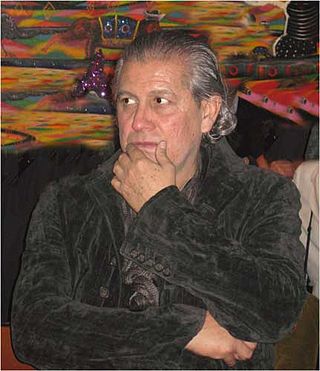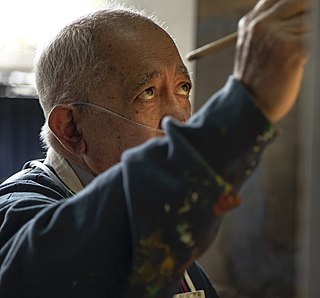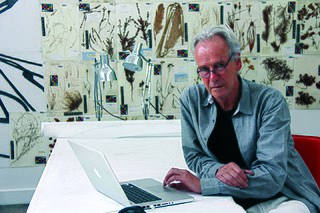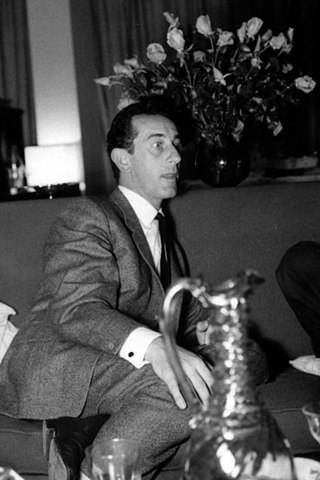Early life and education
Nahum B. Zenil was born in 1947 in Veracruz Mexico. Zenil had a rural upbringing and a lower middle-class lifestyle. Zenil lived with his mother and grandmother in the house that often appears in many of his paintings. The house, when displayed in Zenil's work, is very modest, showing only a small living room, one bedroom, and one bathroom. Zenil's father lived separately, and he worked as a teacher. This disconnection between his family would greatly inspire much of Zenil's later artworks. [3] In Zenil's younger years, he attended La Esmeralda school. However, in 1959, Zenil enrolled at the Escuela Nacional de Maestros in Mexico City,where he study art, including; drawing, watercolor, collage, and montage. [1]
Work
Much of Zenil's works use mixed media on paper or oil on canvas. [3] He preferred to paint on canvas until the materials compromised his health. He quickly returned to collaging on paper. [1] He often uses his image to relieve pressures he felt as a child growing up homosexual in a small town and to comment on contemporary Mexican society. [3] His works illustrate a duality between himself as an "other" and his relationship with the Catholic Church. [3] Within Zenil's mixed media pieces he uses mainly himself as the subject. He pictures himself in his images with many religious figures such as the Virgin of Guadalupe. Within his images are many re-worked traditional Mexican forms like the retablo and ex-voto styles. [1] Zenil was inspired by the works of artists such as Frida Kahlo and Jose Guadalupe Posada. [5]
These influences can be seen in his works, Frida in My Heart and With All Respect, in which the artist actually used the image of Frida Kahlo in his paintings. According to the website glbtq archive, they state that "In a number of ways, Zenil has looked to the art of Frida Kahlo, with its strong dose of self-examination and criticism, as a beacon of inspiration. The portrait of Kahlo is sometimes incorporated into Zenil's works and he creates a lively dialogue between his own portrait and that of Kahlo, whose art has often been seen as representing the triumph of will over adversity." [1] Zenil saw Frida art as a form of salvation, which he used to escape from his everyday life. [3] Zenil's art allowed him to purge himself of the pressures he felt growing up gay, in a small town as a child. [3] The pressures continued to follow him into his life in Mexico city, and as a teacher until he quit, to pursue his art full-time. [3] Many of his works look at a variety of themes and relationships among race, religion, Mexican history, cultural designation, colonialism, male subjectivity and homosexuality. [2]
Exhibitions [4]
SELECTED SOLO EXHIBITIONS
1997 Grey Art Gallery, New York University, New York
1996 The Mexican Museum, San Francisco
1994 Galeria de Art Mexicano, Mexico City
1992 Galeria de Art Mexicano, Mexico City
1991 Nahum B. Zenil...Presents, Museo de Arte Contemporaneo de Monterrey, Mexico
1990 Parallel Project: Los Angeles, San Antonio, Mary-Anne Martin Fine Art/New York
1988 Mary-Anne Martin Fine Art, New York
1985 Galeria de Arte Mexicano, Mexico City
1983 Galeria de la Secretaria de Hacienda Y Credito Publico, Mexico City
1982 Museo Carillo Gil, Mexico City
1980 Casa de Arte CREA, Mexico City
SELECTED GROUP EXHIBITIONS
1995 "Cartographies" traveling exhibition: Canada and US
1993 "Cien pintores mexicanos" Museo de Arte Contemporaneo de Monterrey
1992 "Artistas jovenes" Caracas, Museo de Arte Contemporaneo
1991 "Through the Paths of Echoes" traveling exhibition: US
1990 "Mexico: Out of the Profane" Contemporary Art Centre of South Australia, Adelaide
"Aspects of Contemporary Mexican Painting" The Americas Society, New York
1986 "Memento Mori" Centro Cultural/Arte Contemporaneo, Mexico City
1985 "Mexico: The New Generation" San Antonio Museum of Art, Texas
1984 "Mexican Art" Gothemburg, Stockholm, London
Bibliography
Encyclopedia Copyright © 2015, Glbtq, Inc., Entry Copyright © 2002, Glbtq, Inc., and Reprinted Fr. Zenil, Nahum B. (b. 1947) (n.d.): n. pag. Web.
"Nahum B. Zenil - Artworks, Bio & Shows on Artsy." Nahum B. Zenil - Artworks, Bio & Shows on Artsy. N.p., n.d. Web. 2 May 2016.
"Nahum B. Zenil: Witness to the Self." MIT List Visual Arts Center. N.p., 14 Apr. 2014. Web. 2 May 2016.
Zenil, Nahum B., Edward J. Sullivan, and Clayton Kirking. Nahum B. Zenil: Witness to the Self = Testigo Del Ser. San Francisco: Mexican Museum, 1996. Print.
"Zenil_bio.html." Zenil_bio.html. N.p., n.d. Web. 2 May 2016.








